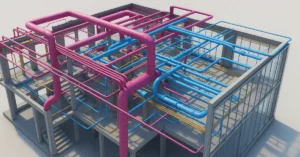Unlocking Efficiency: The Power of APIs in the Construction Industry

In an increasingly digital world, the construction industry has not been left behind. Technology is revolutionizing the way construction projects are planned, executed, and managed, and at the heart of this transformation is the Application Programming Interface (API). But what exactly is an API, and how is it changing the landscape of construction? In this article, we’ll dive into the world of APIs and explore their significance in the construction sector.
Understanding the Basics: What is an API?
An Application Programming Interface, or API, is a set of rules and protocols that allows different software applications to communicate with each other. Think of it as a bridge that enables information and data to flow between different systems. APIs define the methods and data formats that applications can use to request and exchange information. They serve as intermediaries that enable seamless interactions between various software components, systems, and platforms.
APIs in the Construction Industry
Now that we’ve defined what an API is, let’s explore how APIs are transforming the construction industry:
1. Integration of Construction Software
In the construction industry, a wide array of software applications is used for project management, design, scheduling, budgeting, and many other tasks. APIs allow these disparate systems to work together, streamlining processes and reducing duplication of effort. For example, a project management software can be integrated with a scheduling tool, enabling real-time updates and collaboration between project managers and teams.
2. Real-time Data Sharing
Construction projects often require real-time access to data, such as updated blueprints, progress reports, and equipment tracking. APIs facilitate the seamless exchange of this data, ensuring that stakeholders have up-to-date information at their fingertips. This leads to faster decision-making and improved project efficiency.
3. Enhancing Collaboration
Collaboration is key in the construction industry. APIs enable different stakeholders, including architects, engineers, contractors, and clients, to collaborate on a single platform. They can share design files, make comments, and track changes in real-time, reducing the chances of miscommunication and errors.
4. Improved Equipment Management
Equipment management is a critical aspect of construction projects. APIs can be used to connect equipment tracking systems with project management software. This integration provides real-time information on equipment location, usage, and maintenance needs, helping project managers optimize resource allocation.
5. Streamlining Bidding and Procurement
Construction projects often involve complex bidding and procurement processes. APIs can link procurement systems with project management tools, automating the purchase order process, ensuring timely deliveries, and reducing procurement-related delays.
6. Data Analytics and Reporting
APIs also play a crucial role in data analytics and reporting. By connecting various construction software with analytics tools, project managers can gain valuable insights into project performance, identify trends, and make data-driven decisions for future projects.
Case Study: How APIs are Transforming Construction
Let’s consider a hypothetical construction company, “BuildTech Inc.,” and see how APIs have revolutionized their operations.
BuildTech Inc. uses a project management software to plan and execute construction projects. This software is integrated with a Building Information Modeling (BIM) tool through APIs. This integration allows real-time synchronization of project plans and 3D BIM models. As a result:
- Architects and engineers can make design changes in the BIM tool, and these changes are automatically reflected in the project plan.
- Contractors have access to up-to-date blueprints, reducing the likelihood of construction errors.
- Project managers can track progress in real-time, making it easier to identify and resolve issues promptly.
- Collaboration between teams and stakeholders is greatly improved.
The use of APIs has streamlined BuildTech Inc.’s projects, reduced errors, and improved communication, ultimately leading to cost savings and client satisfaction.
Challenges and Considerations
While APIs offer numerous advantages in the construction industry, there are also challenges and considerations to keep in mind:
Data Security:
Protecting sensitive construction data is of utmost importance. API integrations must be designed with robust security measures to safeguard against data breaches and cyberattacks.
Interoperability:
Not all construction software may be readily compatible with APIs. It’s essential to assess the compatibility of existing systems and the availability of APIs in the software market.
Training:
Employees need to be trained to use API-integrated systems effectively. Adequate training and support are necessary to ensure a smooth transition.
Conclusion
APIs have become the unsung heroes of the construction industry, facilitating seamless communication between various software systems and enabling a new level of efficiency and collaboration. Whether it’s integrating project management tools, sharing real-time data, or optimizing equipment management, APIs are revolutionizing the way construction projects are executed. As technology continues to advance, we can expect APIs to play an even more significant role in shaping the future of the construction industry. Embracing these technological advancements can lead to smoother processes, reduced costs, and ultimately, more successful construction projects.
If you’re interested in learning more about architecture firms in Europe, check out this comprehensive list of the top 50 firms compiled by Archgyan. From innovative startups to long-established industry leaders, this list has it all. Take a look and discover some of the most inspiring and influential architecture firms in Europe today.
If you’re interested in architecture and want to learn more about this amazing field, subscribe to our podcast on youtube
For more SketchUp tutorials, head to https://www.sketchupguru.com










